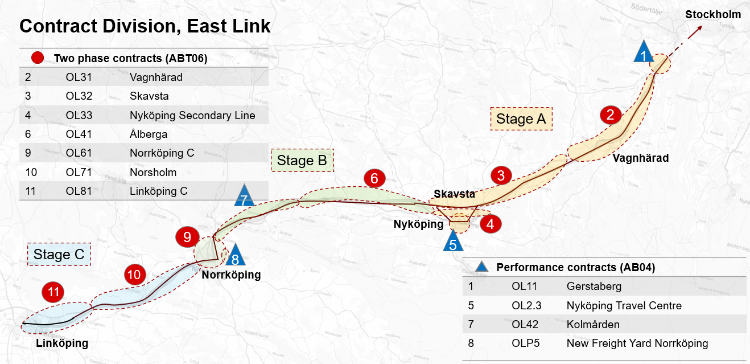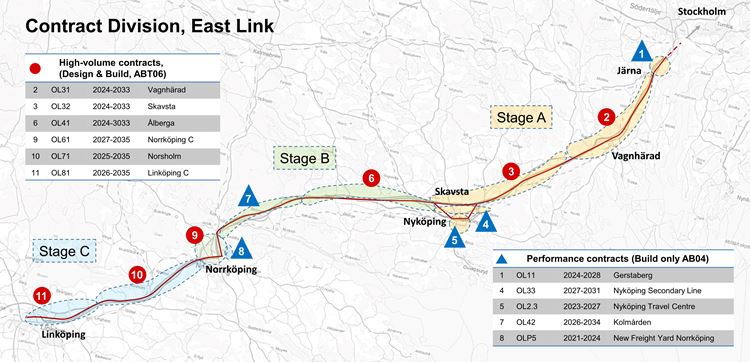
Becoming suppliers’ first choice with new business models – the East Link project as an example
When the East Link project procures its major contracts, suppliers are involved early on in the process in order to capitalise on their experience and produce compelling tender documents.
Ultimately, this will result in better business for both the Swedish Transport Administration and its suppliers.
The East Link is a massive project involving the construction of a total of 16 kilometres of new railway between Linköping and just south of Södertälje. These procurement procedures are each worth around SEK 10 billion, and the total cost is estimated at just over SEK 91 billion. Eight kilometres of railway tunnel, one of the longest in Sweden, will be built at Kolmårdskogen.
The best business model was considered from the perspectives of both the Swedish Transport Administration and the market. As a result, the section was divided into four major sections, with some elements being procured as major design and construct contracts. The idea is to find suppliers who have the muscle to cope with really major works and who are well-established on both the Swedish and international markets.
The initial invitations to tender for the procurement procedure were issued in January, and the strategy was to engage in early dialogue with suppliers. This means that the knowledge available in the market will already have been acquired when the procurement documents are formulated. This approach is suitable for projects of all sizes.

– The Swedish Transport Administration needs to understand what the market needs in order to deliver the best facility, and suppliers need to learn what we need. We need to meet if we are to be able to work together effectively, says Magnus Sjöberg, Programme Director for the East Link project.
– Market dialogues provide us with a good foundation on which we can produce good tender documentation. Ideas are crystallising, and we are bringing in other aspects as well. While the dialogues are ongoing, we are polishing up our tender documentation to ensure it is of high quality. Our client organisation is learning a lot too, and this is knowledge that we have no access to ourselves, he explains.
Suppliers invited for discussions early on
Suppliers are invited to dialogue meetings at various stages in order to consider project criteria and discuss how the tender documentation should be formulated. The procurement procedure is all about the whole process, from design to final execution of the project. There is a lot of discussion about added value, not price.
– We need to capitalise on top skills; our own, and those of the market. What do different suppliers think is important, and what tips and advice can we acquire before the procurement phase? Early collaboration with suppliers is very important for us at this point to help us understand the market, but also to reinforce our own client organisation, says Magnus Sjöberg.
– Suppliers know so much, and we need to capitalise on that. Kolmården, with its eight-kilometre tunnel, is complex. In our discussions we ask suppliers what they would request if they had to submit a tender, he says.
Prequalification required
First, suppliers go through a prequalification phase where they can apply to submit tenders. The companies’ ability to fulfil the contract is then verified. The Swedish Transport Administration looks at factors such as financial criteria, whether the supplier has sufficient expertise, and so on. Suppliers who qualify are then given access to the tender documentation. This also helps to reduce the risk of suppliers submitting tenders and then not being awarded contracts.
The verified cost pricing model is applied, the contractor acquires the resources and materials needed to carry out the work. A certain contractor’s fee has been agreed in addition to the cost price.
Working closely with suppliers on the project
The East Link project is aiming to ensure access to market expertise and innovation. That said, railways are a regulated area and we need to monitor and support projects throughout the process. That is why the Swedish Transport Administration is going to sit down with project suppliers at shared project offices in order to keep the flow of the projects going.
A few facts about the East Link project
- 16 kilometres of double-track railway between Järna and Linköping
- 3 regions (Stockholm, Södermanland and Östergötland)
- 5 municipalities (Södertälje, Trosa, Nyköping, Norrköping and Linköping)
- 5 new travel centres (Vagnhärad, Nyköping, Skavsta, Norrköping and Linköping)
- 25 per cent of the East Link will be built on bridges or in tunnels
- All road and rail junctions will be grade separated
- The speed limit for trains on the East Link will be 250 kilometres per hour
- Preliminary construction period 2024–2034, opening for services in 2035
- The estimated planning cost is SEK 91.4 billion (2021 price level), corresponding to the planning cost in the current national transport plan (2022–2033)
Project Subdivision

